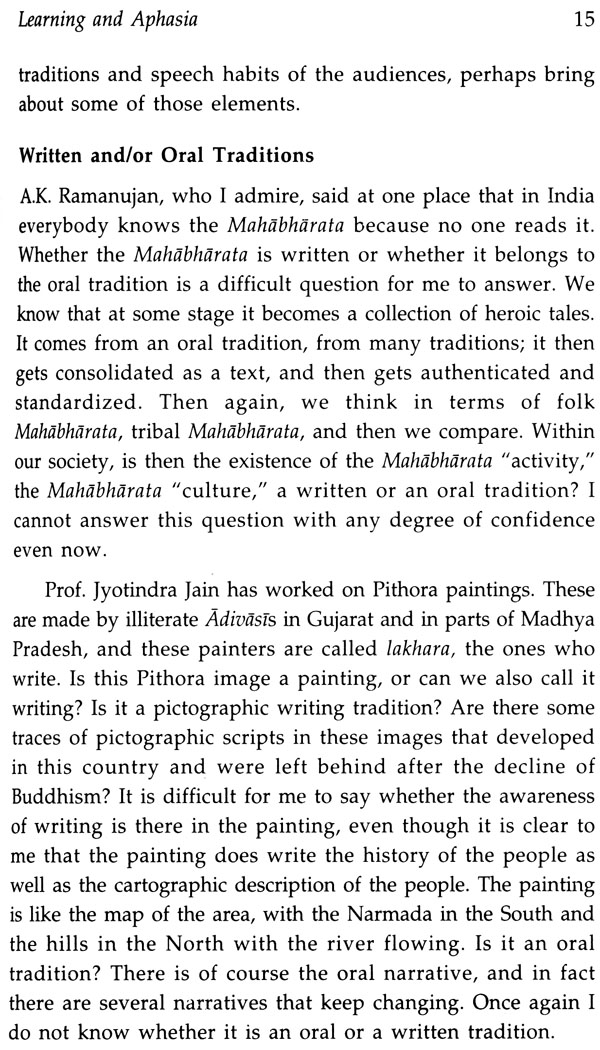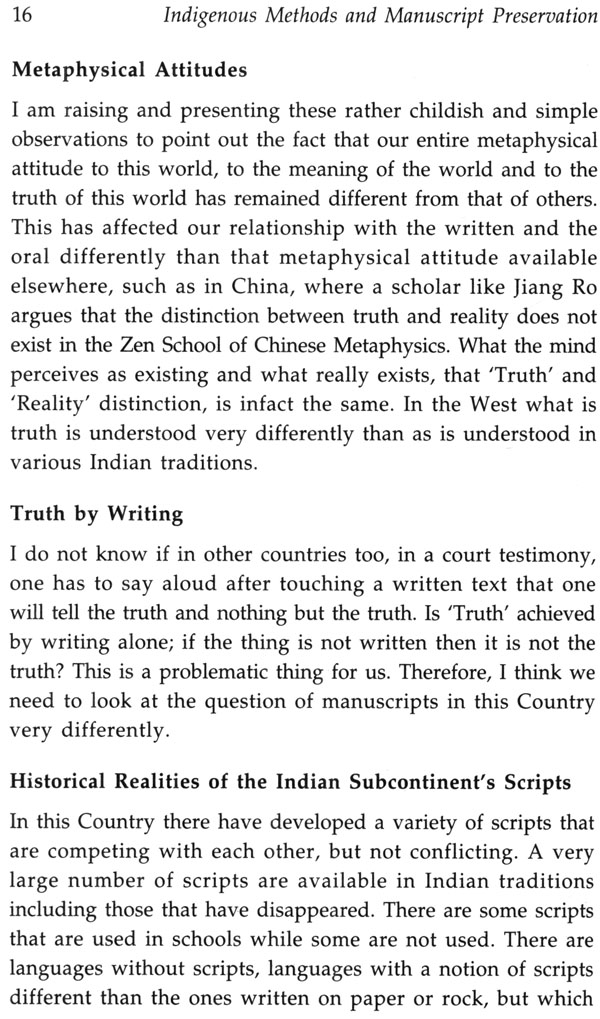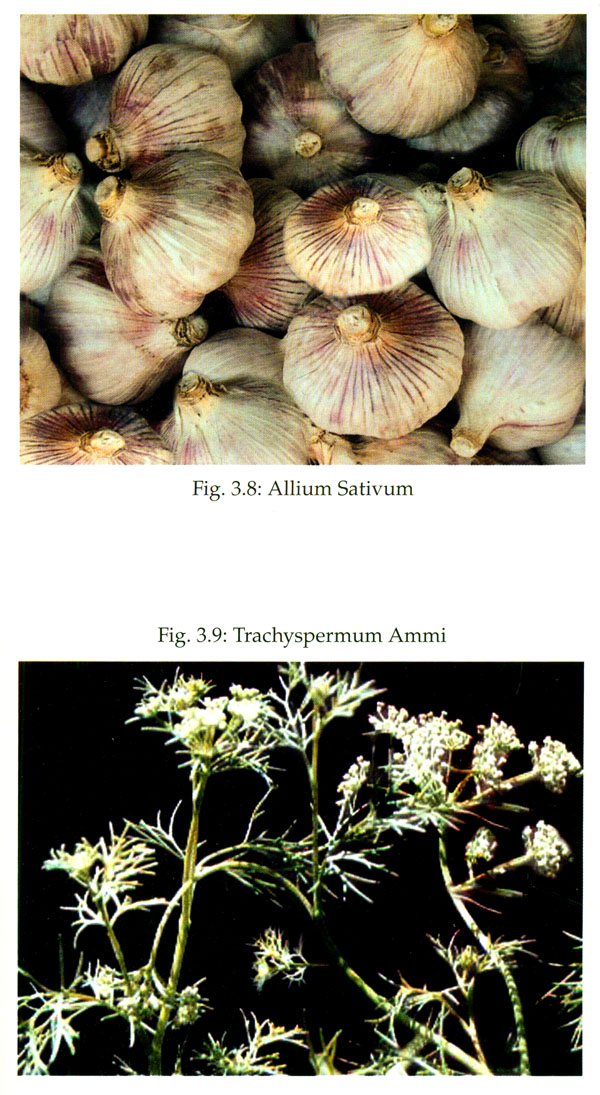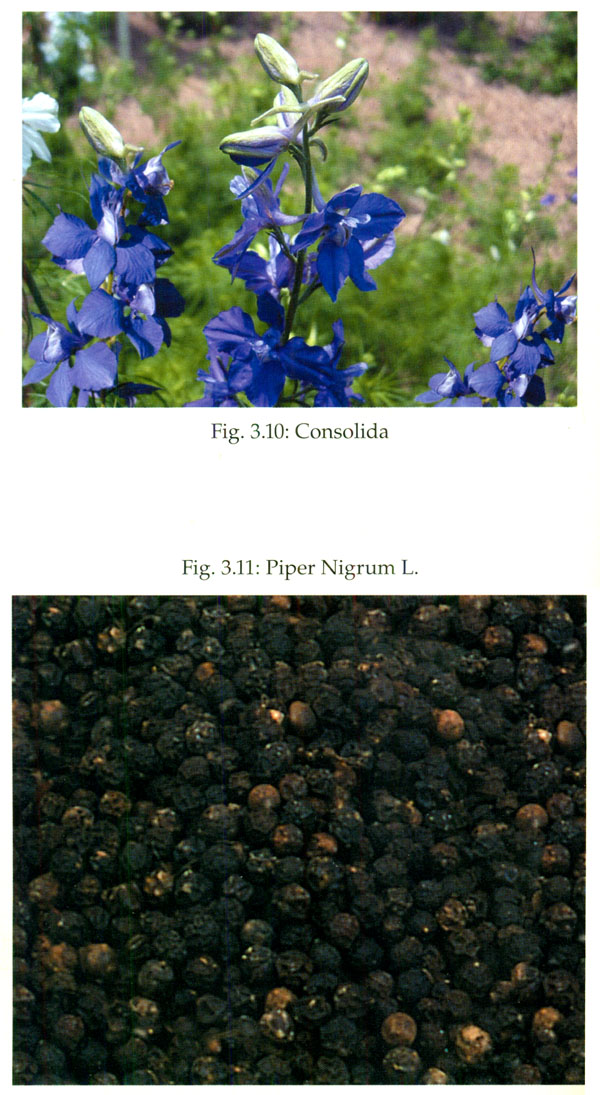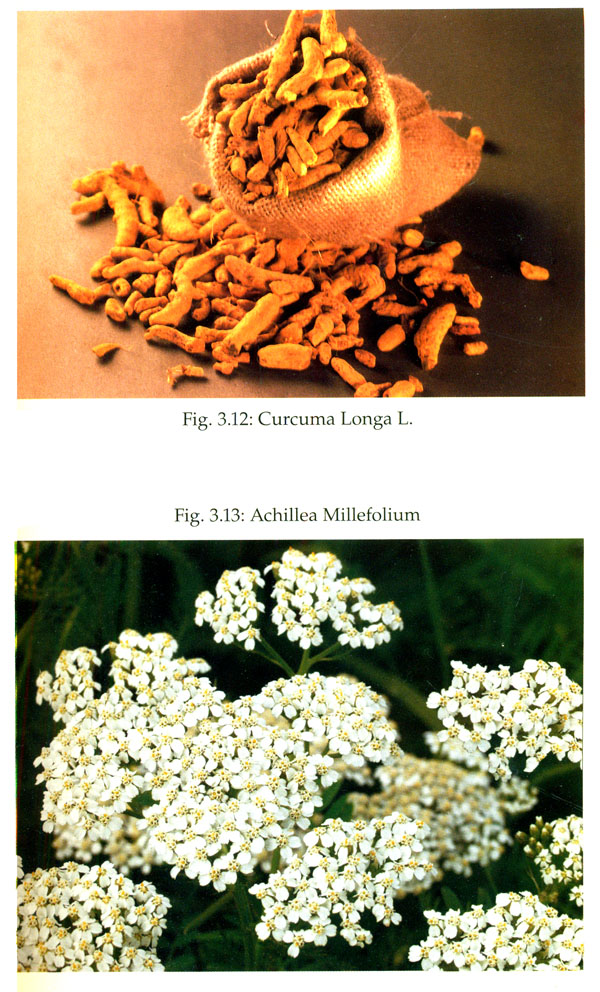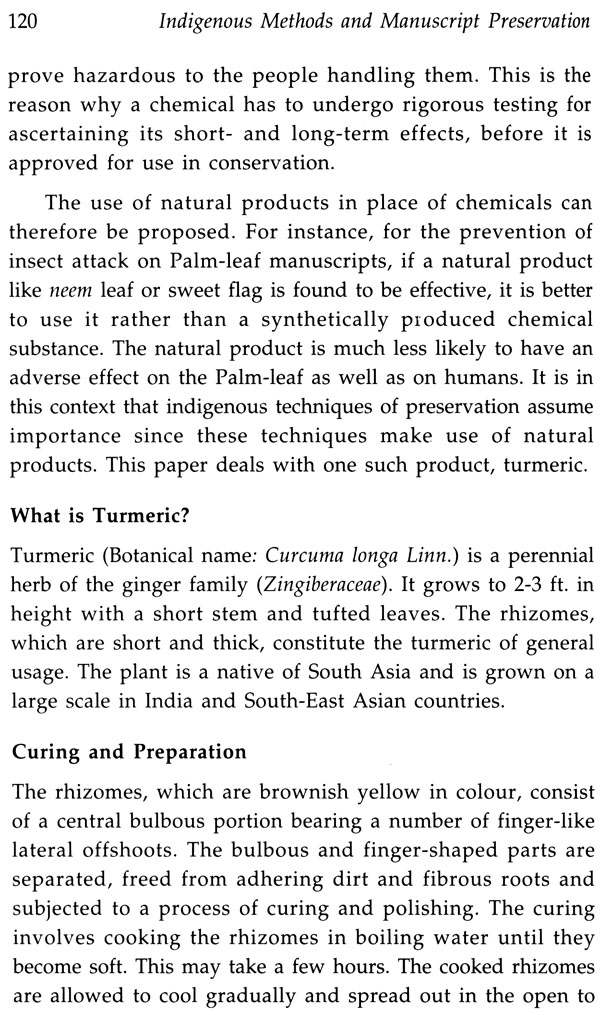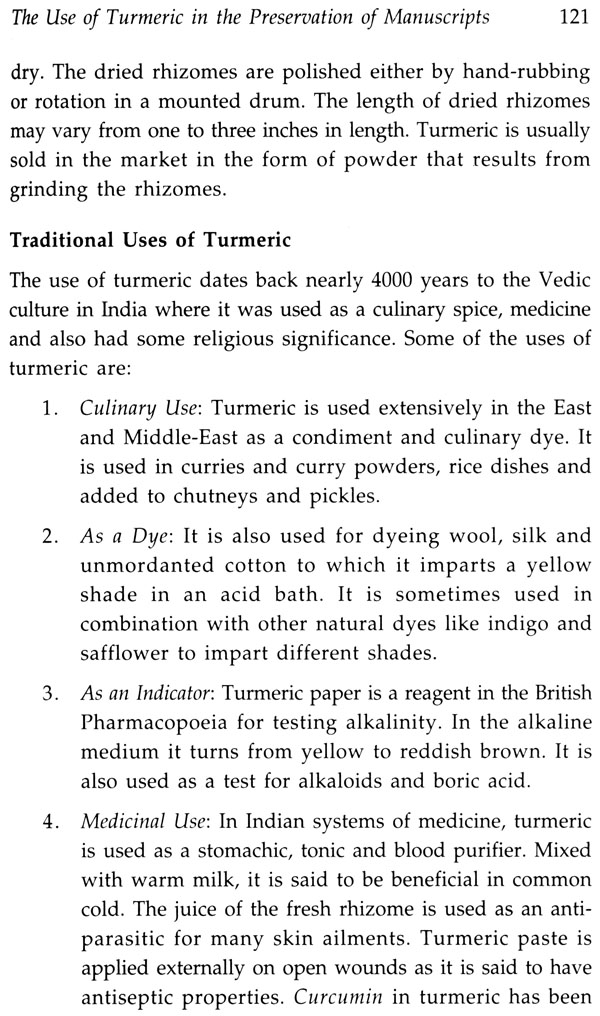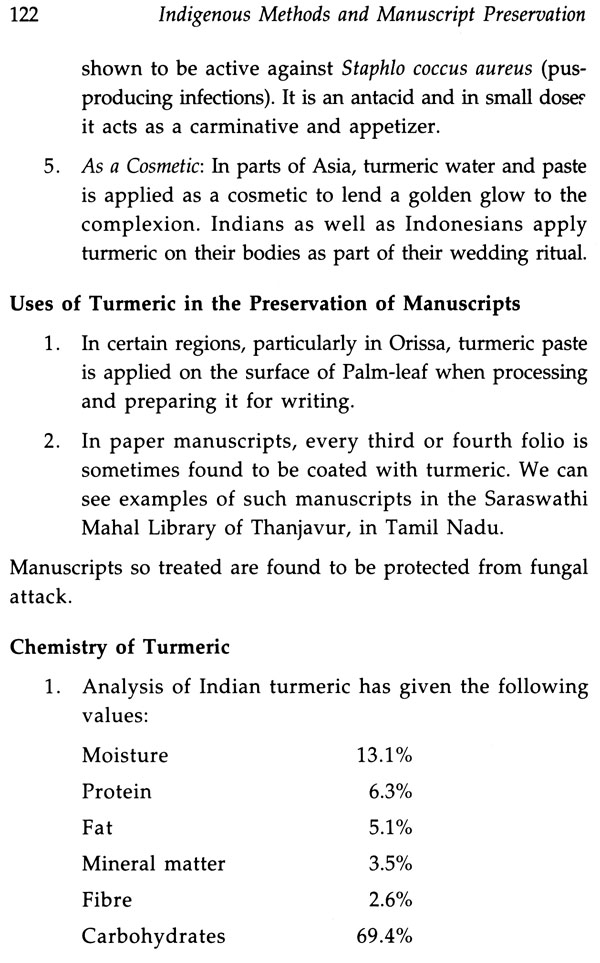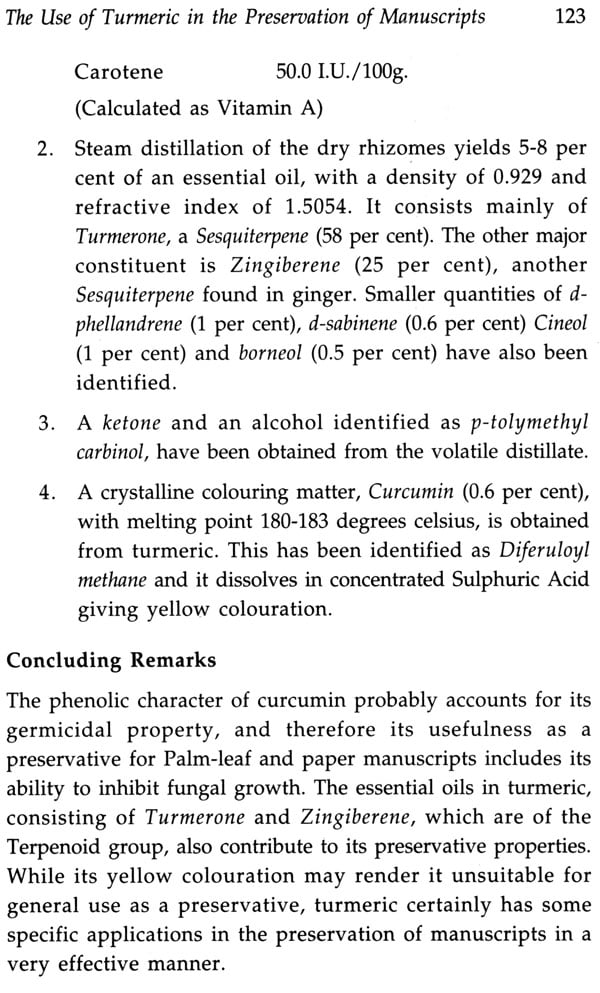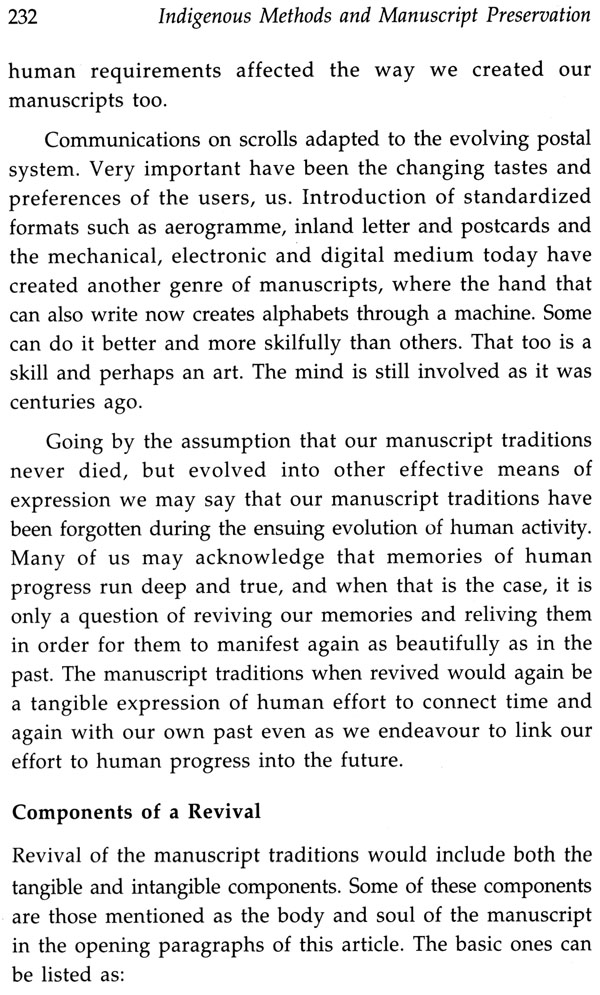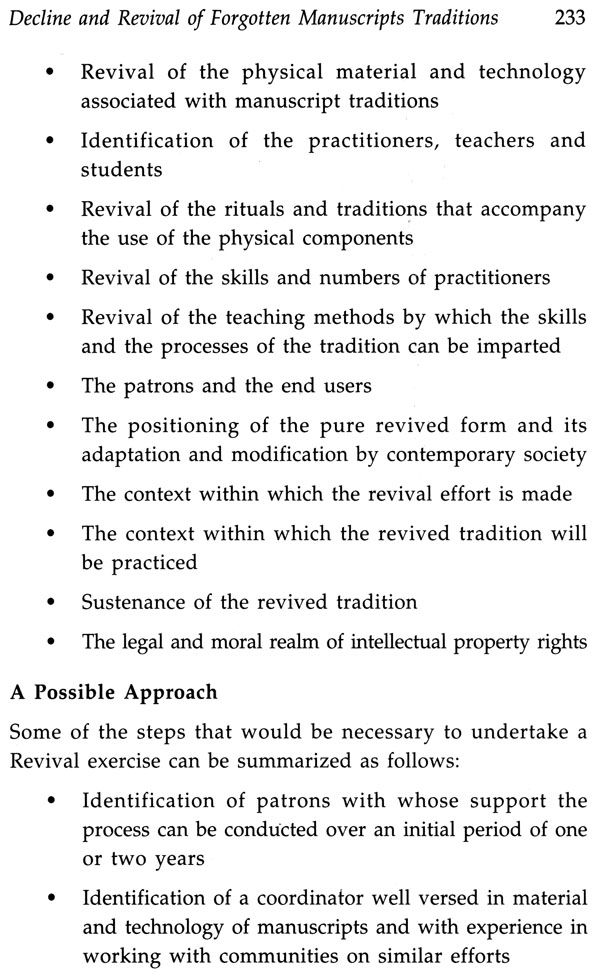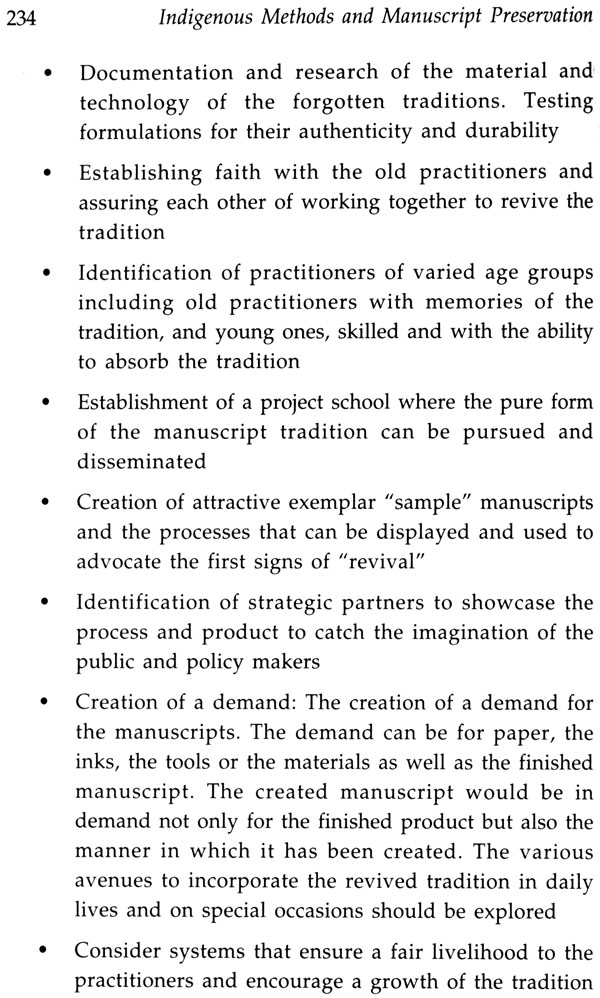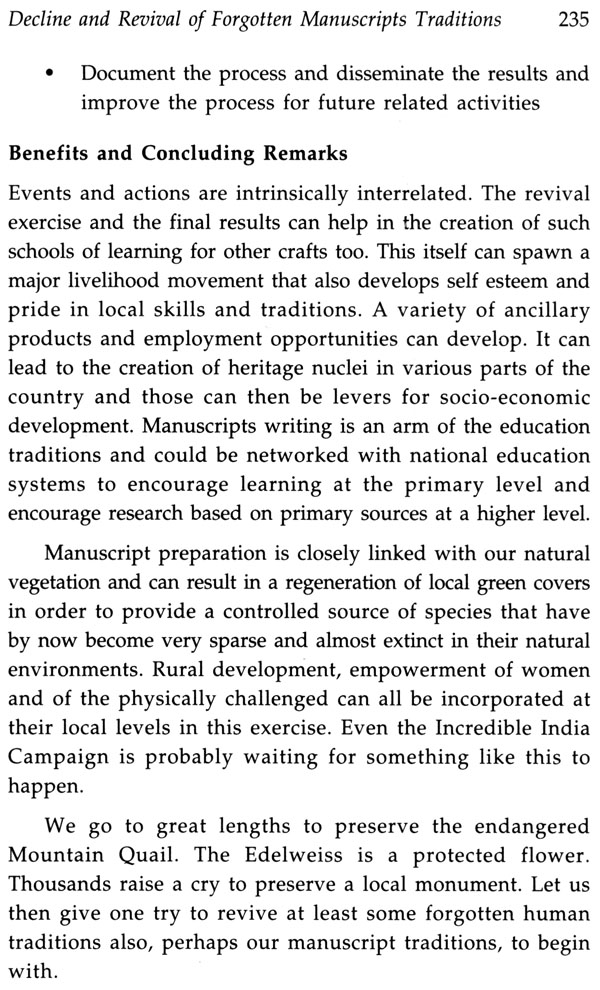
Indigenous Methods and Manuscript Preservation: Samraksika
Book Specification
| Item Code: | NAF685 |
| Author: | Sudha Gopalkrishnan |
| Publisher: | Indira Gandhi National Center for the Arts and D. K. Printworld Pvt. Ltd. |
| Language: | English |
| Edition: | 2006 |
| ISBN: | 9788190402903 |
| Pages: | 268 (23 Color Illustrations) |
| Cover: | Hardcover |
| Other Details | 9.0 inch X 6.0 inch |
| Weight | 590 gm |
Book Description
The National Mission for Manuscripts was established in February 2003 by the Government of India with Indira Gandhi National Centre for Arts (IGNCA) as t he nodal agency. At present it is a part of IGNCA.
Its purpose is to locate, document, preserve and disseminate the knowledge content of Indian manuscripts. The Mission, through its nation efforts, is engaged in preserving and rendering accessible India’s textual heritage. Seeking to link the knowledge of the past with the future. The Mission organizes seminars on various subjects related to Indian. The papers presented in the seminars are collected and brought out under the Samiksika Series.
In February 2007, the National Mission for Manuscripts, in its attempt to bring Indian manuscripts to a platform o f discussion, debate and creative engagement, organized a seminar on, Text and VAriatioins of the Mahabharata: Contextual, Regional and Performative Traditions. While taking a fresh look at the text, the seminar attempted at grappling with the traditions and variations of the great epic across India and beyond.
The National Mission for Manuscripts was launched in February 2003 by the Government of India, under the Ministry of Tourism and Culture, with the mandate of documenting, preserving and rendering accessible the vast reserves of manuscripts in India. The Mission, over the past four years is engaged in creating resource base for Indian manuscripts through nation-wide cultural mapping— national surveys of manuscripts, conservation and manuscriptology workshops, digitization projects, and outreach programmes with a view to bring scholars, researchers, and other interested people into the fold of manuscript studies.
Manuscripts in India go back a long way in history, with centuries of different writing cultures and practices making their way into the textual traditions of the country. In India, diverse knowledge traditions have emanated over centuries, in disciplines as extensive as philosophy, theology, art, literature or the sciences. This pluralism in experience, thought and practice has led to the flowering of diverse manuscript traditions, reflecting various canons of critical thinking and historiography.
In 2005, the Mission launched Samiksika, its Seminar Series, to highlight various aspects of the Indian knowledge tradition as contained in the manuscripts of the past. Since then a number of seminars were conducted across the country, focussing on themes as diverse as medicine, -architecture, Buddhist Textual Canons, the Natyasastra etc. These seminars brought together scholars, researchers, students as well as interested audience on a common platform.
The present volume presents the proceedings of the Seminar on Text and Variations of the Mahabharata: Contextual, Regional and Performative Traditions. As a part of the Fourth Anniversary celebrations of the Mission, the Seminar was organised between 5-7 February, 2007, at the India International Centre, New Delhi. The Seminar was divided into four themes, namely, the 'Textual Complex of the Mahabharata: Diverse Traditions'; 'Regional, Folk and Popular Narratives Contributing to the Text of the Mahabharata'; 'Mahabharata in Visual and Performing Arts: Texts, Contexts and Images'; and, 'The Principles of Purusartha in the Mahabharata'. With papers from some of the stalwarts and renowned scholars in Mahabharata Studies, the seminar attempted at grappling with the traditions and variations of this great epic across India and beyond, while taking a fresh look at the text itself.
The present volume delves into the textual, oral, visual and performing arts traditions of the Mahabharata in its ecumenical, classical versions and regional interpretations, in India and Southeast Asia, and in subaltern reconstructions. It is an exercise in locating the ways in which the Mahabharata has been understood in different places and times, and the manner in which it has endowed diverse community traditions with life, vibration and meaning.
A quest for values underlies and underwrites the discourses, presented in this volume.
In the Purusarthacatustaya or the quadriga of human values, celebrated in the Mahabharata, artha and kama, wealth and pleasure, constitute the empirical pair. It is geared to the spiritual pair of dharma and moksa, discharge of spiritual, moral and social rna, debt, to devas, rsis and pitrs, Gods, sages and ancestors. It is the road to die summum bonum of moksa or liberation. It is a search for the bliss of communion and not a hedonistic pursuit of sensual pleasure. The reflective consciousness discriminating between sreyas from preyas, characterizes this search, and this is the subject of discourse in Santiparvan (D. Prahladachar).
The wealth gathered by nyaya, legitimate means, is the essence of Rajadharma or royal code of conduct in both Tuladhara Javali samvada in the Mahabharata as well as in the Arthasastra. The pursuit of material wellbeing is not divorced from spiritual wellbeing. Wealth garnered without performing dana, yajna, sadacara, veda or satya, gift, sacrifice, good conduct, knowledge or truth, is sterile. The tantrayukti section of the Arthasdstra is concerned with human subsistence in the manusyavatibhumi, human habitat. This is accepted as a fundamental concern in the extended area of the state in the Mahabharata also. (Nrisinha Prasad Bhaduri). Vira rasa or the heroic spirit is embraced as an attribute of dharma. Victory in war sustains lokayatra, the collective pursuit of sanatana dharma, the traditional ethical order. This is synonymous with the human engagement with the eternal ethic of satya, dama, tapa, sauca, santosa, hri, ksama, arjava, jnana, sama, daya and dhyana, truth, self control, penance, purity, satiety, modesty, forgiveness, energy, wisdom, patience, compassion and meditation. Dharma is not inflexible or monolithic but flexible, adapted to the diverse circumstances of life. (Satkari Mukhopadhyaya)
The teacher of music is, therefore, hailed in the Mahabharata for leading the student to sreyas, moksa, to goodness and liberation. A bhavajna, a master of meanings and expressions, he is completed by the right audience of rasikas, samdjikas and vimarsakas, knowledgeable about flavours of emotions, rules of social interaction and discriminative reflection. He is made whole by students fulfilling jati dharma and kulacara, the code of conduct, appropriate to their social niche and lineage. He is not a trader in learning but a saindy person. He rejects superfluous causes, and reconciles contradictory texts. He applies general principles to particular cases, and refers contraries to different situations. He does not discriminate between students of noble birth and quality. He teaches diem to concern themselves with what is before diem and to act on what they should. (Leela Omcherry)
The Mahabharata tradition is complex and not monolithic in its pursuit of Purusarthas. This is evident from the besetting preoccupation with the element of die tragic in die demonic other, in die performance of Karnamoksam in the Kataikuttu tradition in South India, in a kind of a sacrificial rite, which celebrates the possession of Kama- by die demonic quality of Tanasura or Naraka, and condemns him to play a role on die wrong side of dharma, and destroy himself, in full consciousness of his fate. (Hanne M de Bruin).
The pratinayaka, the anti hero, is celebrated in Bhasa's Karnabhara, and also in Kutiyattam and Kathakali theatre in Kerala. The actor as an interpreter and narrator invokes war as the ultimate victor, death as the hero, which brings out love and innocence in the heart, hardened against these. Face to face with death, Duryodhana knows the value of maternal love for die first time. The purva paksa or prologue of the Mahabharata is completed by Harivarhsa, which provides trsnaksaya sukha, felicity, born of destruction of desires, as die epilogue. The demonic force is also celebrated in the depiction of Draupadi as a warrior goddess, Virapancali. Draupadi is both Devi and Dayan in Muslim regional epics. (KG.Paulose).
The relentless working of the tragic flaw leads human beings to spurn salvation, refuses to belong to one another, or to God. It compels them to play out their destiny to a bitter and abortive end. The heroic battle between the good and evil, the dissolution of dreams in dust and ashes, provide the titanic scale, complexity and poignancy to the Mahabharata characters. The depiction of Draupadi by Mallika Sarabhai or Shaoli Mitra, or the cinematic and theatrical presentations by B.R. Chopra and Rahi Masoom Raza have, while Peter Brooks's film lacks, this tragic grandeur. The epic is thus read as relevant to the hour, not in terms of a remembered past, a projected future, but of a present, when the best lack all convictions, the worst are full of passionate intensity, and only an anguished cry can be raised about the eternal indifference to the voice of dharma. (Pradip Bhattacharya)
The volume has also described the indexical dislocation, symbolic inversion and subversion, ruptures, discontinuities and pluralities, articulated in vernacular versions of the epic.
Female liberty has been associated with tribal matrilineal and liminal patriarchal traditions of Kuru Pancala Janapada outside the metropolitan centres of Madhyadesa. Women are entitled to moksa only after performing the kama samskara, the rites of love. In svayamvara, the women are the price of manly valour, virya sulkd. (Shalini Shah) On the other hand, the Bheel Bharath describes the primal quality of sexual longing and the radiant celebration of sex without any moral taint or tirade in a vivid account of die disgrace of Arjuna and rape of Draupadi by Vasuki Naga. The aggressive courtship of Arjuna by women, the dalliance of Radha with Krsna, disguised as a bangle seller, are described without any prudish criticism. Gariga dominates Santanu. Kunti is born of Sakti, aureoled in awesome glory. Draupadi invites all the wives of Arjuna to a feast. The Yaksa in yaksaprasna poses as a jalayogini, a water sorceress testing a man, as virgin water which cannot be taken away without marriage. Indrani chastises roguish sages and chides Indra for not doing so with the searing rebuke, "woman's body is not something to etch their artwork on." Uttara is the courageous wife of child courage, Balormmat Abhimanyu, and looks for amarkuppi to save him. The women have their own gurus. They are neither in abject dependence on men nor are they neurotically self critical. (Satya Chaitanya).
In the Mewati Mahabharata of the tribal pastoral Meo Muslims, the narrator performer, the Mirashi singer, invokes Goddess Bhavani along with Ustad and Allah, for inspiration, so that they can please the pdriyd audience, and make them raji or agreeable. There is a debate between Guru Gorakh and disciple Augad, the voice respectively of orthodoxy and modernity, about the legitimate role of women, as courtesans or ascetics. Gorakhnath or Puran Bhagat gives fertility to barren Gangadhar and Kunta, makes the garden green and fills the lake with water. (Shail Mayaram).
Draupadi Amma, Gandhari Amma are worshipped by depressed classes in Tamil Nadu. In the Aravan festival, transvestites and hermaphrodites celebrate the birth of Aravan from the loins of Arjuna and snake woman Ulupi. Krsna spends a night with Aravan, assuming feminine form. Alli Arasani Malai learns martial arts in a Gurukula, and wins back the Pandyan kingdom in war. She punishes the love smitten Duryodana, and parades him in the street, nailed on a ladder. She is reluctant to submit to Arjuna, who seduces and hypnotizes her in the guise of a Sanyasi, a transvestite, a snake, drugs her with passion and rolls on her "like a mustard on a polished mirror, a bee on a jasmine flower." A variant of the myth are of princess Pavazhakkodi, who is seduced by Arjuna, and of Queen Perarasiyar, daughter of Purushan Devi, conceived from pollen ,carried by southern winds from Sri Lanka. (Vijaya Ramaswamy)
The oppositional, counter cultural, transgressive traditions of folk Mahabharatas, nursed by Naths, Bairagis, Yogis and Satpant Ismailis in the twelfth or thirteenth c, or by the Meo Muslims in the eighteenth c, have also been celebrated in the volume.
The Pandun brothers are depicted as pastoral brothers in the Mewati Mahabharata, the Pandun Ka Kara, the war of the Pandins and Kairus. They challenge exclusive Rajput claims to authority and set out for a kingdom without authoritarian kingship. The Meo Muslims come from the untouchable Dhadhi subcaste, and sing the Mahabnarata in dohds, in the popular Rajasthani Dingal Apabhramsa. They claim to be Joduvamshis and have been in constant conflict with the centralizing Muslim, Jat, Rajput and British kingdoms in the area between Vraja and Kuruksetra. Satyavadi Rdjans are hailed for royal rectitude, for acting as fences to protect the fields, their domains. (Snail Mayaram)
The transgressive nature of the regional texts is also articulated in the close connection of the floral and faunal in the human world. The search for the rhino by Arjuna, Pandu's birth as a street dog, birth of Kunti and Gandhari from a dead eagle, in Bheel Bharath, the overwhelming dominance of Vasuki Naga, over Arjuna and Draupadi, the birth of Alli in a flower, the entry of Arjuna into the Alli's apartment in the guise of a snake, are examples. (Satya Chaitanya)
The episode of shadow piercing or Nilalkkuttu is adapted, in the Adiparvan performance of the older Malayalam work, Thirunilamdld, and from oral pattus, attakathas and Kurumba and Pana aboriginal songs. The local folk and tribal traditions provide background to the atavistic shamanistic description of deviant abhicara and counterabhicdra rituals, used to put the Pandavas to sleep, or to revive them, in classical Malayalam theatre performances. (A. Purushothaman and A. Harindra-nath)
The volume also describes the journey of the Mahabharata to Southeast Asia and East Asia through Buddhist jatakas, avaddnas, legends, and its mutations in local folklore and myth.
In the process of this diffusion, the epic is installed, taught, sculpted and recited, in the temples of Kampuchea. Eighteenth, ninteenth centuries Thai works deal with the story of Aniruddha and Usha. The rhythm, culture and grace of the epics are transmitted through purvas, kakavins, specially the Kakavin Bharatayuddha, and paruans in Indonesia, the Wayang Kulit, performed by ritual Dalang artists and Gamelan orchestra. There are parallels to the epic stories in Chinese and Mongolian versions. (Lokesh Chandra) In die inscriptions, the Kings and heroes are equated with Visnu, Siva and Buddha in their life and work. The recitation of the epics is seen as contributory to royal victory and prosperity. Japanese Kabuki drama tells the story of Rsyasrnga, renamed as Ekasrnga. The theme of giant Vakasura and its Japanese counterpart Shutenboji, the story of Urvashi and Sakuntala and the fairy maiden Hagoramo in Japanese Noh play also show the links. The dialogical style of discourse is shared by Korean and Zen Buddhism with the epic, specially for solving riddles on practical problems. (Anita Khanna)
The volume describes the preliminary step, taken for preparing a critical edition to understand the epic philology in terms of the drsta path to the mantras visualized; the sruta path for retrieval of orality; krta path for reaching the core through various readings, via heuristics, recensio, emendations and higher criticism; and the prokta path of reconciliation of diverse readings. (Vasant Kumar Bhatt) There is also an attempt, in the manner of Western scholarship, to examine the epic threadbare, in terms of melopoiia, melody, lexis, direction, opsis, spectacle, mythos, plot, ethos, characters and setting, dianoia, concepts, following the tradition, inaugurated in Aristotle's Poetics. (Mehta 1990)'
There is a discussion on the methodology adopted for preparing a critical, definitive and consensual edition of the Mahabharata for the first time by the Bhandarkar Oriental Research Institute under the general editorship of V.N. Sukhtankar. In this exercise, begun in 1925, 1300 manuscripts have been examined by 1966. It has been established that both the southern and northern recensions and their eight versions in diverse scripts are independent copies of a single text, transmitted orally. In this critical edition, the most common, mutually agreeable denominators have been brought together with a preference for the least tampered Kashmir version. Solecisms considered original have been preserved. Readings adjudged different and time-tested interpolations have been included in the footnotes and appendix. In this manner, contradictions generated in oral transmission have been respected instead of resorting to the vulgate or the best text available. (M.A. Mehendale) In the process of this philological exercise, the attempt to strip Draupadi has been detected as apocryphal, added by later redactors. The evidence for this is considered to be minimal, inconclusive and contradictory, in the absence of any allusion in any Purana, including the Bhagavata, Harivamsa or post Mahabharata plays. The story is considered to be an interpolation, even in the critical edition. (Pradip Bhattacharya).
Use of modern technology, including speech recognition, minimization of data entry, alignment of data with original manuscripts, conversion of data base format, word or phrase level search, highlighting of the images, collation of readings, generation of reports, retrieval, mark up and publishing have been discussed for deciphering, editing, indexing, searching and preparing a concordance of texts on the epic, along with other Vedic texts. The electronic and statistical surveys of the subjunctive forms of the epic have been seen as being outside the epic verbal system. As such, slokas, violative of Pihgala's provisions, are being analyzed, in terms of digital philology, on an interactive global platform. The affinities and differences are being read as e-texts. Formulaic and grammatical patterns are being used to trace the bardic epic. A biological phylogenetic analysis of various approaches to the epic is being undertaken for similar and dissimilar manuscript readings. (P. Ramanujan)
A discussion of the variant meanings of the Mahabharata has been undertaken, in the attempt to penetrate the historical layers and reach the core text. The epic has been read as an account of the defeat of virtuous Siva worshipping Kauravas by Vaisnava Pandavas; an eschatology of creation and destruction, played out by Visnu and Siva; a war between Gods and demons; a solar drama, telescoping natural phenomena into a mythic format; an intra tribal or anti Brahmin conflict; a conspectus for a social organization, based on a dual, Indo Iraninan Pharatrie; a historical event; an Indo European myth, transmitted through pre-vedic, Vedic and para Vedic characters; as a theme modeled on Rajasuya sacrifice. It is a story, rethought and retold through a diversity of oral translated into variant texts against an archetype. Its contemporary resonance is felt in its appreciation by Hollywood as an eternal human story; as an allegory about a nuclear Armageddon, and, in its universal appeal as an epic of global significance. (Saroja Bhate)
| Series-2 | ||
| Preface | ix | |
| Introduction- Kalyan Kumar Chakravarty | xi | |
| Transliteration | xxiv | |
| Section -I | ||
| Textual Complex | ||
| 1 | The Critical Edition of the Mahabharata-Its Constitution, Achievements, and Limitations | 3 |
| 2 | The Mahabharata in Asian Literature and Arts | 25 |
| 3 | The Mahabharata: the Global Epic | 37 |
| 4 | The Mahabharata in the Literary Creativity of Indonesia | 51 |
| 5 | Some Reflections of the Mahabharata in Japanese Literature | 81 |
| 6 | Was Draupadi ever sought to be Disrobed? | 89 |
| 7 | Computational Database of the Mahabharata for Assisting Research/ Analysis | 101 |
| 8 | महाभारत के पाठ के आलोचनात्मक अभ्यास मे चुनौतिया | 113 |
| Section-II | ||
| Regional Traditions | ||
| 9 | Tamil Women and a Mahabharata Myth | 125 |
| 10 | Nilalkkuttu and other Mahabharata Episodes from Kerala | 149 |
| 11 | The Epic Imagination and its (Dis) continuities: The Mewati Mahabharata | 161 |
| 12 | Bheel Bharath: When the Mahabharata Incarnates Down Under | 185 |
| Section-III | ||
| Performance | ||
| 13 | Ideals in Music as seen Through the Mahabharata | 221 |
| 14 | Life outsides the Text: On the Background and interpretation of the Mahabharata Characters in Contemporary Kataikuttu Performances | 235 |
| 15 | The Mahabharata on Screen | 247 |
| 16 | The Mahabharata as Represented in the Classical Contemporary Theatre of Kerlala | 271 |
| Section- IV | ||
| Purusartha | ||
| 17 | Purusarthas: Values of Life | 281 |
| 18 | महाभार तोक्तो धर्म पुरुषार्थ | 295 |
| 19 | Artha-Purusartha | 301 |
| 20 | The Principle of Kama Purusurtha in the Mahabharata: Its Conception and Variations | 321 |
| Note on Contributors | 331 |


